#Civic Center Media
Text

Gainesville! It's getting close to that time of year again! I present to you the "Transiversary: Celebration of Trans Lives." This time as an all day event with doors at 12:30pm! Music from 1-7pm. It's a $5-20 sliding scale cover. We've got music, art, and community.
For your musical pleasure, we have Confession Kids, Dumpster Meds, Hellcat Tendencies, Degenerate State, BeBe Deluxe, Quil Darling, X Dirty Fingers, and a special DJ set by Wild Creatrix.
We also have our fantastic drag performers Lyre Antics and Delirium Primadonna Haze.
And our wonderful artists vending: Pillsbury Bread Co, Angel Obscura, hammflower, and Fae Geleh. Gainesville Food Not Bombs will also be tabling this event!
Flyer by Milky
#trans#queer#transgender#trans man#tran woman#nonbinary#agender#genderfluid#drag#art#Transiversary#gainesville#gainesville florida#civic media center#florida
21 notes
·
View notes
Text
few days too late for this to be relevant, but just so everyone knows, the only piece of 9/11-related media worth engaging with is and always will be the broadway musical come from away
#i think come from away is a good piece of 9/11 media partially because it's not about the attacks or even about america#it's about the planes that were grounded in newfoundland immediately afterwards and the community the townsfolk formed with the passengers#come from away makes me cry like a baby and i ain't too proud to admit that#they're showing it at my local civic center next year and i'm not gonna be able to go and that makes me SO sad
3 notes
·
View notes
Text





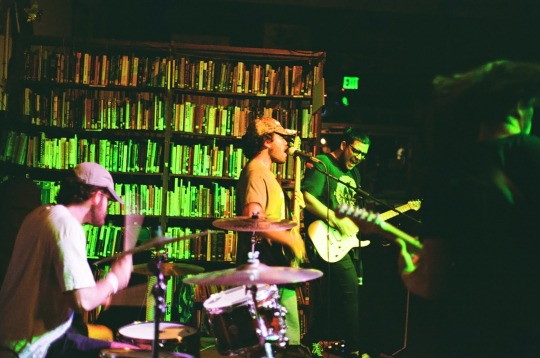

2 notes
·
View notes
Text
Research Links Local News, Civic Health of Communities
Research Links Local News, Civic Health of Communities
Newswise — PORTLAND, Ore., Oct. 20 — A new report from the University of Oregon’s School of Journalism and Communication’s Agora Journalism Center found that Oregonians are unequally served by local news media and that some communities have few places to turn for local news. The report also describes how journalists and civic leaders are deeply worried about the state’s ability to confront its…
View On WordPress
#Civic Engagement;us politics;Government/law;Media Consumption;Journalism Innovation;Community-Centered Journalism;Civic Health;Local News;Re#civil liberties#Government/Law#Media and Journalism#Newswise#U.S. Politics#University of Oregon
0 notes
Text

The sunlight is hitting the Civic Center MARTA Station in a nice way this morning.
Info on those sculptures...
Artist: Paul Freundt
Title: 'As It Goes Through'
Media: painted steel
Year: 1981
The sculptures weigh 21 tons apiece, per the MARTA website.
37 notes
·
View notes
Text
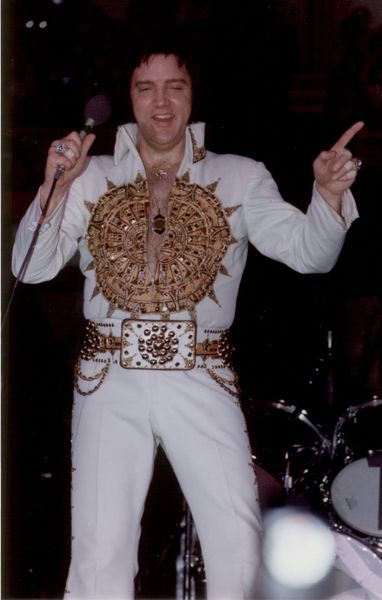
On May 29th, 1977, Elvis played the Baltimore Civic Center to an audience of just under 13 000. Like many shows from around this period, the truth has been somewhat obscured by slanted press reviews which have been uncritically rehashed in subsequent biographies. This show has earned some notoriety owing to Elvis leaving the stage for possibly as long as 30 minutes mid-show, leaving poor Charlie Hodge to lead the band through a series of introductions and solos in the face of increasing audience impatience.
Accounts vary as to what followed. One report suggested Elvis returned to the stage and completed the show in a 'desultory fashion', while another reported that 'he came back on like gangbusters'.
Interestingly, the unscheduled intermission didn't even rate a mention in the Baltimore Sun review, which offered the headline 'Presley Has the Old Magic Still', and described the show as 'intelligent and well-paced'.
"...Of course, by this time Elvis is virtually impervious to all criticism. The media have to buy tickets if they want to review him or take his picture, he doesn't need them (The Sun's photographer, who didn't have a ticket, was not allowed in the Civic Center.) He doesn't even have to sing. People come just to see him as they would visit a national monument...To the thousands who cheered him last night, he is a symbol of innocence tinged with just the right combination of sex, show business and country music. They don't know why exactly, but they still love him..."
The performance was preserved in an audience-recorded bootleg, and seems to be a generally solid show. Elvis tried his best to make amends following his absence, taking requests and making a big effort. Had he given the audience an extra 15 or 20 minutes beyond his usual stage time, he might just have got away with it.
(Review transcript thanks to Francesc Lopez at elvisconcerts.com)
#elvis history#elvis presley#elvis in the 70s#rock history#elvis fans#elvis#elvis 1970s#musicians#live music#elvis aaron presley
60 notes
·
View notes
Text
Overwhelmed By Advertising? The Battle For Cincinnati Consumers Has Raged For More Than A Century
Depending on the source, it is estimated that each American is confronted by 6,000 to 10,000 advertising messages every single day. That immersive media onslaught swelled as we started carrying little video screens around wherever we go, but invasive and obnoxious marketing has bothered Cincinnatians for much more than a century.
For example, on 20 July 1871, a correspondent for the Cincinnati Times related an enjoyable voyage he had undertaken down the Ohio River. After praising the service of his riverboat’s staff, the remarkable scenery along the river, the picturesque little town he floated by, the writer registered one complaint, about a cliff near the town of Hanging Rock:
“High up on the face of this wall of white sandstone, hundreds of feet beyond the reach of a scaling ladder, I noticed a patent medicine advertisement. It was penciled there by a man let down with ropes from above, and the letters are large enough to be read from the deck of a steamer two miles distant. I was sorry to see this defacement. It is bad enough that all the fences throughout the land should be made to lie for patent medicines without debasing the hill-sides with such marking. I suppose that when the ‘chemical affinity necessary to be the motor of some immense flying machine’ shall be discovered, some enterprising patent medicine man will be plastering the face of the moon with some of his ‘wonderful remedies.’”
If only the poor man knew what lay ahead! Even in the 1870s, almost every vertical surface in Cincinnati was slathered with posters, placards and bills advertising shows at the local theaters, patent medicines and political candidates. Cincinnati was the center of the bill-posting world. For one thing, Cincinnati was among the top printing cities of the United States, with the mighty Strobridge Lithographing Company dominating the poster industry.
Also, Billboard magazine was headquartered here in Cincinnati. What we now think of as a music magazine, Billboard was founded in Cincinnati as a trade publication for men who posted “bills” on walls. From its first issue in 1894, Billboard covered the entertainment industry, such as circuses, fairs and burlesque shows, and also created a mail service for travelling entertainers. Initially it covered the advertising and bill-posting trade and was known as Billboard Advertising.
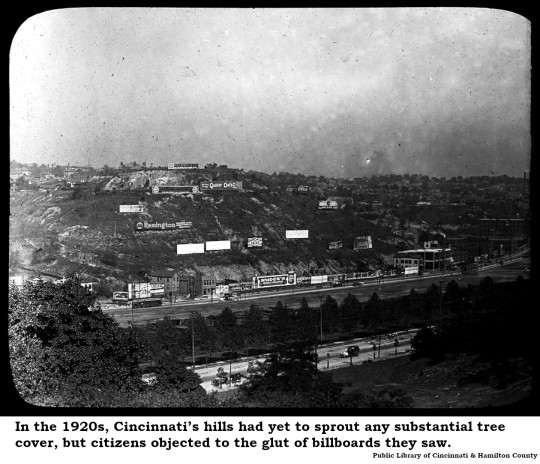
Far from inspiring civic pride, advertising rankled Cincinnati residents as they witnessed visual pollution encrusting the region’s hillsides. Leading the opposition was the Municipal Art Society – a sort of ad-hoc predecessor to today’s Urban Design Review Board. The opening shot was fired 24 August 1896 when the Enquirer reported:
“A matter that will undoubtedly be of interest to the business men is the fact that war has been declared by the Cincinnati Municipal Art Society against advertising signs on fences along the car routes and drives of the city. The art society maintains that these signs mar the beauty of the city, especially in the case of landscape scenes on the hills and in the suburbs, and that they are offensive to the public taste.”
The Society was persistent. It took five years but the Cincinnati Post reported [24 November 1901] that the Baldwin Piano Company had demolished 200 feet of billboards erected on company property along Gilbert Avenue. The Post described this as the “first result” of the Society’s campaign.
The Municipal Art Society was soon joined by some strange bedfellows. The Cincinnati Business Men’s Club, among whose members were certainly a number of advertisers who employed billboards to disseminate their messages, created its own Municipal Art Committee to lobby for restrictions on outdoor advertising. On 1 June 1907, the committee circulated a postcard illustrated with a photo of signage clogging the view from the Grand Central Depot, with the sarcastic caption, “A Nice Welcome To Cincinnati.”
As early as 1895, the city chased the Fountain saloon’s advertising off Fountain Square, but appears not to have drafted a comprehensive law about outdoor advertising until 1909 when, as part of a broader safety ordinance, the city adopted limitations on the size of billboards, their placement near thoroughfares and the materials to be used in their construction.
While the city pondered how to encourage commerce while maintaining attractive views, the entire billboard industry was gaining momentum through a Cincinnati entrepreneur named Philip Morton. Before Morton, “bill boards” were basically fences on which bill posters slapped printed advertisements glued up with a flour-water paste. Morton took outdoor advertising to a new level, according to Jay Gilbert, who has researched his influence on marketing [Cincinnati Magazine September 2016]:
“By 1898 he’d become the Steve Jobs of roadside blight. Doing business as Ph. Morton, Phil was an early pioneer of putting ads into free-standing frames called ‘bill-boards’ and plunking them down everywhere. Eventually every railroad route and motorway in America had its view ruined by a Ph. Morton billboard.”
Even the powerhouse Morton found himself in the city’s crosshairs. Parks Superintendent John W. Rodgers, according to the Enquirer [20 September 1907], exasperated by Morton’s billboards blocking the view of Inwood Park, erupted.
“Park Superintendent Rodgers yesterday tore down over 12,000 feet of big billboards that stretched along for a distance south of Hollister street, facing Vine street, in front of Inwood Park. The billboards were 12 feet high, about 1,000 feet long and contained the advertisements of leading firms of the city, and were illuminated at night with electric lights. They had been at that place for years.”
All of those billboards were leased by Philip Morton who, as coincidence would have it, dropped off a check to pay the lease while workmen were busily engaged demolishing his thousand feet of signage. This was the Boss Cox era in Cincinnati where the right hand was very often ignorant of the left hand’s activity. And so it was, while the Park Superintendent was demolishing billboards on Vine Street, the Board of Public Service pondered a lease for billboards along Gilbert Avenue. That’s right – the same Gilbert Avenue divested of billboards just six years earlier.
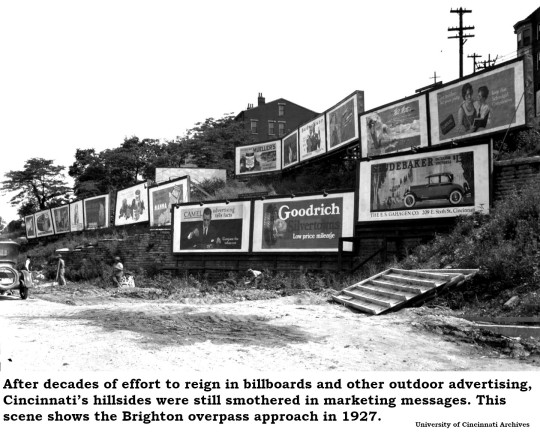
A common theme of cartoon artists at that time was the eventual coverage of all available exterior surfaces with advertising signs and slogans. In response, Cincinnati Post cartoonist Elmer Andrews Bushnell sketched City Hall wrapped from sidewalk to parapet in advertising while George Barnsdale Cox and his minion, August “Garry” Herrmann, happily apply more posters and Mayor Julius Fleischmann hides behind a billboard.
The battle raged for decades. Photographs from 1927 show dozens of billboards crowding the hillside over the Brighton overpass to Central Parkway and the Enquirer [24 March 1929] begged for relief because billboards and other unsightly structures had a negative effect on property values:
“What of the gaudy billboard that intrudes itself into a residential district, the sign which girds the tree or telephone pole, the roadside ‘shack’ which is made more ugly with bizarre advertisements? Do they affect values?”
A century later, we hardly notice billboards anymore. We’re too busy texting while we drive.

10 notes
·
View notes
Text
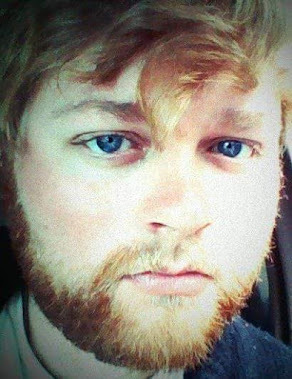

Colin Arey has been missing since January 25th, 2017. The then-26-year-old man was last seen in Brewer, Maine. According to reports, Colin's stepfather dropped him off at the Brewer Civic Center on the day of his disappearance. He has never been seen by his loved ones again.
That same day, Colin reportedly spoke to a co-worker via Facebook Messenger. This is the last known reported contact from him; he has also never been heard from again. Since then, Colin's social media accounts, bank accounts, and credit cards have all been inactive.
Prior to disappearing, Colin student art in New York City. He eventually moved to Bucksport, Maine, where his stepfather and siblings reside. For some time period, Colin reportedly worked as a substitute teacher and education technician at the G. Herbert Jewett School in Bucksport.
Colin was not reported missing until June 25th, 2018 - nearly a year and a half after his disappearance. An article about his disappearance from August 2018 states it took some time for his family to realize he was missing. The report states, "Colin Arey's family members were talking recently, and it was determined that the last confirmed sighting was in January of 2017, when a family member gave him a ride to the Brewer area. Family members told Bucksport Police, when they called recently to report him missing, that they're close, but that they don't have regular, daily contact with each other."
There has been very little media reporting on his case. However, there has been a bit of online speculation. Friends of Colin's have made various postings on different platforms to help spread awareness about his disappearance, which has sparked discussion about what might have happened to him.
In 2021, a friend of Colin's made a post on Reddit about his disappearance. The friend commented, "He lived with his stepfather and siblings, his mother is deceased. He didn’t drive so his stepfather would drive him to work and wherever he needed to go. I’ve spoken with his relatives, and they seem to think that he is dead at the hands of his stepfather. The local police haven’t done a whole lot to bring attention to the case. He was also a gay man and was in the online dating scene in the area. This is all I really know about the case and as time goes on it bothers me more and more."
It is easy to see how some might suspect the stepfather. Reports state that he was the last known person to have seen Colin. It also appears that Colin lived with the stepfather at the time of his disappearance, yet the stepfather never reported him missing. It seems impossible that the stepfather/siblings would not notice that Colin was missing for over a year.
Still, the stepfather has never been publicly named as a person of interest or suspect in the case - nor has anybody. Colin's disappearance has now become a cold case. The Bucksport Police are in charge of the investigation. If you have any information that could lead to Colin's whereabouts, please contact Bucksport Police Department at 207-469-7951.
12 notes
·
View notes
Text


Mychal Threets, the magical librarian from Civic Center Library in Solano County, who was becoming so popular on social media, spreading Library Joy and Book Joy, but felt he needed to resign from the Library because of all the internet trolls who were coming for him, has been hired by PBS, as a result of good people, (who will always outnumber those with mental and emotional decay), linking “PBS” and “PBS Kids” to Mychal’s posts on Tik Tok, the former Twitter and Threads.
As a result PBS noticed, and is hiring him to be PBS’s resident librarian for a social media series. I cannot believe what this angelic person, whose only aim is to spread joy and reading promotion, had to endure, but this is great news for PBS and kids and adults alike. Good wins!
7 notes
·
View notes
Text

This is from Forbes, hardly a bastion of "libtards" so it carries some serious weight with people like me.
"As American democracy rebounds, we need to return to a standard of truth when it comes to how the government communicates with the governed. The easiest way to do that, from where I sit, is to create repercussions for those who don’t follow the civic norms. Trump’s lawyers lie gleefully to the press and public, but those lies, magically, almost never made it into briefs and arguments – contempt, perjury and disbarment keep the professional standards high.
So what’s the parallel in the dark arts of communication? Simple: Don’t let the chronic liars cash in on their dishonesty. Press secretaries like Joe Lockhart, Ari Fleischer and Jay Carney, who left the White House with their reputations in various stages of intact, made millions taking their skills — and credibility — to corporate America. Trump’s liars don’t merit that same golden parachute. Let it be known to the business world: Hire any of Trump’s fellow fabulists above, and Forbes will assume that everything your company or firm talks about is a lie. We’re going to scrutinize, double-check, investigate with the same skepticism we’d approach a Trump tweet. Want to ensure the world’s biggest business media brand approaches you as a potential funnel of disinformation? Then hire away.
This isn’t cancel culture, which is a societal blight. (There’s surely a nice living for each of these press secretaries on the true-believer circuit.) Nor is this politically motivated, as Forbes’ pro-entrepreneur, pro-growth worldview has generally placed it in the right-of-center camp over the past century — this standard needs to apply to liars from either party. It’s just a realization that, as Daniel Patrick Moynihan famously said, in a thriving democracy, everyone is entitled to their own opinions, but not their own facts. Our national reset starts there."
[Thanks Tim Hackett]
7 notes
·
View notes
Video
youtube
How Beijing targets Chinese Canadians through foreign influence operations, March 3, 2023
Alliance Canada Hong Kong executive director Cherie Wong joined Power & Politics Friday to discuss how Beijing targets Chinese Canadians. Akshay Singh and Dennis Molinaro, two experts in foreign influence operations in Canada, also weigh in on the scale and goals of foreign interference activities in Canada.
CBC News
@allthecanadianpolitics
There is an important distinction being made here that the foreign interference from China seeks to be pervasive by co-opting individuals, institutions, and community groups. The interest and influence is party agnostic and sees us in the Chinese diaspora as an entry point: whether in support of certain electoral and policy outcomes, controlling what information gets propagated into the communities, appropriating issues like discrimination and increasing distrust in our own systems and institutions, or directly and indirectly targeting people of interest.
***
It has been strongly implied in the recent reporting about Chinese interference in Canada that it has been a failing (if not to the benefit) of the Liberal government and Trudeau, rather than systematic attempts to influence Canadian politics and economics for decades coupled with our country’s complete underestimation of China and the United Front.
In my own experience the Chinese-Canadian media and political consumption has undergone an extreme shift into partisanship with clear pro-China and anti-China camps rather than aligning into our political parties.
The faltering of Hong Kong-based press, media, political freedom, and ties with Taiwan and the greater diaspora community has seriously depleted any sort of moderate and critical voices in English or Chinese coming directly from the region, with writers and journalists re-immigrating or retreating from public view.
Cold War rhetoric and posturing over Taiwan, Tibet, Xinjiang, Hong Kong, as well as exposed espionage and foreign interference operations is opening new fault lines within and directed at diaspora while deepening the isolation of the domestic Chinese population.
The pop cultural center has moved with the economic affluence into the Mainland, catered to and directly influenced by a network of state-run broadcasters and private corporations ultimately answerable to the Chinese government. It can be difficult to engage with any of it as entertainment let alone to keep up with news without expending a lot of energy consuming it critically.
Tangentially but also related, many of Hong Kong’s pro-democratic political figures (the Hong Kong 47) that interacted with the outside and independent press or engaged other countries in the aftermath of the 2019-2020 protests and subsequent political organizing have been effectively silenced, charged, and/or jailed. They are only now being formally sentenced under the highly controversial Hong Kong national security law.
The political reverberations led to a postponed and then uncontested election for their legislative and executive body without any substantive opposition, the closure of multiple news organizations, civic rights groups and unions, the local polling institute, and the effective silencing of editorial independence at their public broadcaster.
Self-censorship and the chilling affect is extremely strong by those regions directly affected as well as the diaspora communities, out of fear or apathetic hopelessness it is eroding our ability to speak, associate, or engage with these issues freely no matter where we are.
#United Front#China#Chinese#diaspora#foreign policy#Cherie Wong#Alliance Canada Hong Kong#Akshay Singh#Dennis Molinaro#Canada#media#politics#Chinese Communist Party#visibility#accountability#geopolitics#national security#news#CBC#censorship#political repression#Hong Kong 47
38 notes
·
View notes
Text

The sold-out planned ‘‘doom loop” tour of drug-infested San Francisco was canceled, and community leaders tried to hold a “positive walk” instead — only to still stroll past addicts getting high and homeless camps.
Curious tourists and locals had shelled out $30 a pop on Eventbrite for a weekend tour promising an up-close-and-personal experience with San Francisco, “the model of urban decay” — complete with walks past its “open-air drug markets and vacant office and retail spaces.
But the tour’s guide, only listed as “SF Anonymous Insider,” failed to show at Saturday’s event, claiming he was afraid to carry it out because of all the controversy around it.
“Unfortunately, the substantial media interest means that it is not possible to preserve my anonymity while publicly posting the tour’s time and meeting location,” he wrote in a message to customers, according to the San Francisco Chronicle.
Community activist Del Seymour and others with the nonprofit Code Tenderloin — who had gathered at the tour’s designated starting point to protest the event — then led about 70 people on an nearly 2-mile “anti-doom loop tour” through areas such as City Hall, Union Square, Mid-Market and the Tenderloin District.
One of their stops, the Civic Center district, was eerily empty except for half-baked drug addicts bent over after taking a hit on fentanyl and other drugs.
As the tour group walked past shuttered stores such as the Whole Foods grocery store on Market Street, drug deals were happening in broad daylight.
A homeless man yelled at some in the group as they passed by the encampments.
Del Seymour, nicknamed the Mayor of the Tenderloin District, talks to tour participants of the Celebrate Tenderloin Tour outside of San Francisco City Hall on Saturday.David G. McIntyre
As Seymour took the group to the Glide Memorial Church and a nightclub called the Power Exchange in the Tenderloin neighborhood, participants passed by rows of tents, many with homeless addicts passed out inside.
In the corners, men exchanged crumpled up money for balls of foil.
Some openly smoked fentanyl and other drugs as the tour group walked past them.
The stench of urine mixed with human and animal feces was at times overwhelming as Seymour quickly walked the group past the notorious corner of Hyde and Turk streets, where drug deals run rampant especially “once the sun goes down,” a local told The Post.
Link, continued under the cut
Tour participants on the Celebrate Tenderloin Tour cross the heart of the Tenderloin District at Turk and Hyde Streets in San Francisco on Saturday.David G. McIntyre
Some of the homeless men and women laying on the street corners looked up in confusion as the tour group walked past them.
Serena, a group member who brought snacks and water in her bag, stopped to give some of the homeless men and a woman some of her food.
The woman, who was passed out on the ground, was so high on drugs that she couldn’t even lift her head to say thank you.
Another man took a long deep breath out of a pipe and blew smoke into the air.
A homeless man washes his feet on the curb as tour participants on the Celebrate Tenderloin Tour walk through the Tenderloin District.David G. McIntyre
He grabbed one of the snacks Serena offered.
“It’s hard because housing here has turned into a crisis,” Serena told The Post. “It feels like City Hall isn’t listening to the community and this is the fall out of the broken systems that we are seeing.”
During the two-hour tour, Seymour talked about various programs available in the Tenderloin, including subsidized low-income housing where families pay only $400 for a three-bedroom apartment that normally would rent for $5,000 to $8,000 a month.
Seymour also pointed to the various services available to the homeless in the area, including free meals and housing, but also told The Post part of the struggle involves getting those who need help to recognize they need it.
A homeless encampment on the street as tour participants on the Celebrate Tenderloin Tour walk through the area.David G. McIntyre
“If I’m unhoused and have mental challenges, you can’t just spend 30 seconds and then walk away after I say no,” he said. “You need to sit down with me and talk to me in a gentlemanly manner. It might take an hour, it may take two, but you have to give me that time and build that trust with me so we can make some sort of compromise.”
As for the “doom loop” tour, the activist said, “I fell out of the chair laughing because of the meanness that people in San Francisco have to even suggest something like this.
“This is not healthy or helpful at all for our people,” he said. “We don’t want to live in the situation we are living in. We want to do something about it, but you can’t do something about it when people beat you down.”
Dany Vallerand said she initially wanted to take the advertised “doom loop” tour because she usually didn’t feel comfortable going through the area on her own.
Participants and organizers sing outside of San Francisco City Hall to before they take the Celebrate Tenderloin Tour.David G. McIntyre
“I just thought it would be very interesting, and I hoped the money would go to a good cause, like some charity,” she told The Post. “I was hoping to explore the Tenderloin in a way that I normally wouldn’t feel comfortable doing on my own and accompanied by other people with a different point of view.”
Vallerand said that while she was “perfectly happy” to take the anti-doom loop tour instead, she noted the economic downtown of San Francisco has affected many residents such as herself, as flagship businesses have left the area and property value going down.
Vallerand said she recently sold her condo $150,000 below her asking price.
“It is very hard to see it happening here,” she said.
Tour participants of the Celebrate Tenderloin Tour walk past the now closed Whole Foods Market in the Mid-Market Street area.David G. McIntyre
More than 20 businesses, including Nordstrom, Whole Foods and Old Navy, have left the area since January 2022.
While locals such as Vallerand decided to take the opposition tour, others who signed up for the original “doom loop” version were disappointed they didn’t get what they paid for and left.
But Serena said she decided to participate in the “positive” tour because the initial Eventbrite listing offended her.
“They wanted to showcase the doom of the Tenderloin, and to me, it sounded very f–ked up,” said Serena, who did not want to provide her last name. “I can’t believe it sold out.”
16 notes
·
View notes
Text
Navigating Law and Politics on Social Media: A Guide to Sharing Constructive Information and Avoiding 'Fake News'

In today's digital age, social media has emerged as a formidable force in shaping public opinion and discourse, particularly in law and politics. With their unparalleled reach and influence, social media platforms have become indispensable tools for informing and engaging citizens about critical issues such as pending legislation, electoral processes, and the performance of political leaders. However, this virtual landscape has its pitfalls, chief among them being the proliferation of misinformation and the spread of 'fake news.' As such, the need for responsible engagement with social media in law and politics has never been more pressing.
Topic Area:
The topic area of this discussion revolves around the responsible use of social media in navigating law and politics. The intended audience includes individuals actively participating in online discussions on legal matters, political developments, and societal issues. This audience may comprise citizens, activists, policymakers, journalists, and others interested in staying informed and engaged in the digital public sphere.
Current State of Social Media:
Social media platforms such as Facebook, Twitter, LinkedIn, Instagram, and Snapchat have become integral to modern communication. These platforms offer diverse features and functionalities catering to user preferences and engagement styles. Facebook and Twitter, for instance, are popular choices for disseminating news articles, sharing opinion pieces, and fostering discussions among users with varied ideological leanings. Conversely, LinkedIn serves as a professional networking hub where individuals can exchange insights, build professional connections, and access industry-specific information.
Moreover, the emergence of visual-centric platforms like Instagram and Snapchat has transformed how information is absorbed and shared online. These platforms leverage visual storytelling through images, videos, and infographics, making complex topics more accessible and engaging to diverse audiences.
Research supports the widespread adoption of social media platforms, particularly during significant events such as elections. According to a report by the Pew Research Center (2020), smartphones have become indispensable tools for accessing information during electoral campaigns, with a substantial portion of the population relying on social media platforms for news consumption and political discourse.
Attention and Engagement:
In social media, capturing and maintaining users' attention is paramount to effectively conveying information and fostering meaningful engagement. Two fundamental principles that underpin successful engagement strategies on social media include:
Visual Storytelling: Visual content, such as images, videos, and infographics, has been shown to enhance user engagement on social media platforms significantly. Research indicates that posts containing visual elements receive higher levels of interaction, including likes, shares, and comments (Smith, 2019). Visual storytelling techniques can convey complex legal and political concepts in a more digestible and memorable format, enhancing audience engagement and comprehension.
Interactive Content: Interactive content, such as polls, quizzes, and live Q&A sessions, fosters active participation and dialogue among users. Social media users can create a sense of community and ownership around the topics discussed by soliciting their audience's feedback, opinions, and contributions. Additionally, interactive content encourages users to invest their time and attention, leading to deeper levels of engagement and interaction (Kumar, 2018).
Benefits of Social Media Use:
Despite the inherent challenges associated with social media, there are several potential benefits to its use in the context of law and politics:
Enhanced Civic Engagement: Social media platforms give citizens unprecedented opportunities to engage with political processes, express their opinions, and advocate for change. By facilitating real-time communication and information-sharing, social media empowers individuals to participate actively in democratic discourse and civic affairs (Boulianne, 2019).
Information Accessibility: Social media platforms serve as democratizing agents by democratizing access to information and breaking down traditional barriers to knowledge dissemination. Users can access a diverse array of perspectives, opinions, and sources of information, thereby fostering a more informed and nuanced understanding of legal and political issues (Groshek & Al-Rawi, 2018).
Risks of Social Media Use:
However, the pervasive nature of social media also poses significant risks and challenges, particularly in the realm of law and politics:
Disinformation and 'Fake News': The ease of content creation and dissemination on social media has led to the proliferation of disinformation, misinformation, and 'fake news.' False or misleading information, deliberately spread to deceive or manipulate users, can undermine public trust in institutions, sow discord, and distort political discourse (Wardle & Derakhshan, 2017).
Echo Chambers and Polarization: Social media algorithms often prioritize content based on user preferences and engagement patterns, leading to echo chambers—virtual spaces where individuals are exposed only to information that aligns with their beliefs and viewpoints. This phenomenon exacerbates ideological polarization, stifles constructive dialogue, and reinforces confirmation bias (Sunstein, 2018).
Conclusion:
In conclusion, social media has emerged as a double-edged sword in law and politics, offering opportunities and challenges for informed citizenship and democratic engagement. By leveraging the power of social media responsibly—through fact-checking, critical thinking, and constructive dialogue—individuals can contribute to a more informed, inclusive, and resilient public sphere. Navigating the complexities of social media requires vigilance, discernment, and a commitment to upholding democratic values and principles in the digital age.

References:
Boulianne, S. (2019). Social media use and participation: A meta-analysis of current research. Information, Communication & Society, 22(7), 873-900.
Buffer. (2019). State of Social 2019. Retrieved from https://lp.buffer.com/state-of-social-2019.
Groshek, J., & Al-Rawi, A. (2018). Social media and political participation: Crowdsourcing civic engagement in online political communities. Social Science Computer Review, 36(6), 707–725.
Kumar, S. (2018). Interactive content marketing: Using interactive content to engage your audience. Berkeley, CA: Apress.
Lazer, D. M., Baum, M. A., Benkler, Y., Berinsky, A. J., Greenhill, K. M., Menczer, F., ... & Schudson, M. (2018). The science of fake news. Science, 359(6380), 1094–1096.
Smith, A. (2020). Social Media Use in 2021. Pew Research Center. Retrieved from https://www.pewresearch.org/internet/2021/04/07/social-media-use-in-2021/.
Sunstein, C. R. (2018). #Republic: Divided democracy in the age of social media. Princeton University Press.
Wardle, C., & Derakhshan, H. (2017). Information disorder: Toward an interdisciplinary framework for research and policymaking. Council of Europe Report.
3 notes
·
View notes
Text
I had orchestra practice today at a civic center and it had a little paper saying that taking pics and videos inside was allowed and to upload them to social media to get some love
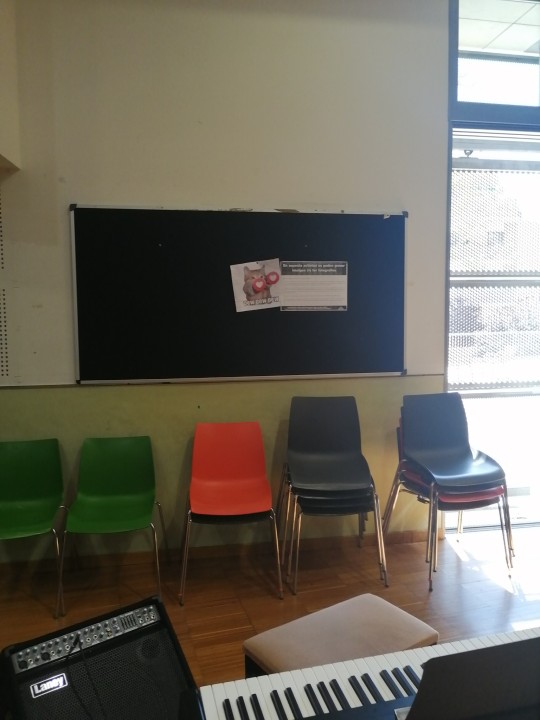
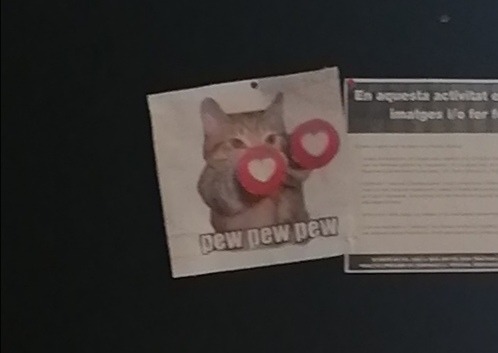
pew pew pew
14 notes
·
View notes
Photo

Chris Pratt’s ‘The Terminal List’ Gets Second Season & Prequel Series Starting Taylor Kitsch At Prime Video
The Terminal List is continuing — and becoming a franchise for Amazon Studios. I have learned that Prime Video has finalized a Season 2 renewal for the hit series starring and executive produced by Chris Pratt, and also has picked up an untitled prequel/Ben Edwards origin series headlined and executive produced by Taylor Kitsch, from The Terminal List creator/executive producer David DiGilio.
I hear other Jack Carr characters who have or have not appeared yet on The Terminal List, an adaptation of his 2018 novel, will be featured in the prequel, including Pratt’s Navy SEAL James Reece and Raife Hastings, a former SEAL pal of Reece’s whose potential arrival was set up in Season 1 of the mothership series.
A rep for Amazon Studios declined comment.
Talks about a second season of The Terminal List — which has been a big hit for Prime Video, reaching No. 2 on Nielsen’s weekly Top 10 streaming ratings chart — have been going on for months. I hear that during those conversations, Pratt suggested expanding the series with a prequel, which he is executive producing through his Indivisible Productions alongside Kitsch.
According to sources, also executive producing the offshoot are DiGilio, who serves as showrunner; fellow The Terminal List executive producers Carr and Antoine Fuqua; and producers include Max Adams, a writer who is a former Army Ranger; and Pratt’s longtime coach Jared Shaw, a former Navy SEAL.
The prequel is described an elevated espionage thriller that follows Ben’s (Kitsch) journey from Navy SEAL to CIA paramilitary operator, exploring the true darker side of warfare and the human cost that comes with it.
The Terminal List, a co-production from Amazon Studios and Civic Center Media in association with MRC Television, tells the story of James Reece (Pratt), a Navy SEAL who seeks to avenge the murder of his family.
Following the outsized ratings success of the eight-episode first season, which launched July 1, Pratt hinted that more episodes are coming during a September appearance on Carr’s podcast Danger Close.
“To the rabid fans of The Terminal List out there, you have nothing to worry about,” he said. “We love you and appreciate your support. It’s our life’s mission to make sure you can come back to the well. We are working away.”
Added Carr, “There may be some cool stuff on the horizon being discussed.”
Besides Pratt and Kitsch, the main cast of the conspiracy thriller’s first season also included Constance Wu, Riley Keough, Arlo Mertz and Jeanne Tripplehorn.
Waco alum Kitsch will next be seen in the Netflix limited series American Primeval and Painkiller, both directed by Pete Berg.
Pratt next will be seen reprising his role as Star-Lord in Guardians of the Galaxy Vol. 3 and heard as Mario in The Super Mario Bros. Movie. His recent credits include The Guardians of the Galaxy: Holiday Special for Disney+, Thor: Love and Thunder, Jurassic World: Dominion and The Tomorrow War, which he executive produced.
24 notes
·
View notes